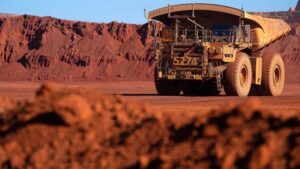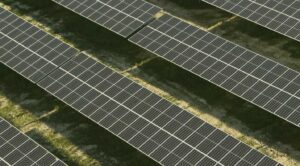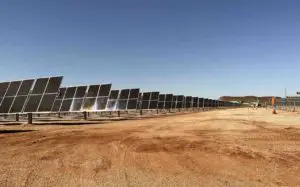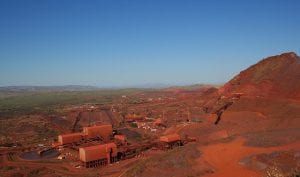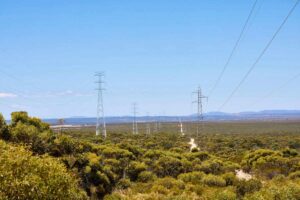The north African country of Morocco has achieved a new low for wind energy costs, securing average bids of just $US30/MWh from its tender for 850MW tender of large-scale wind energy projects, with the lowest at around $US25/MWh.
The pricing – revealed by its energy ministry at a ministerial round table at the International Renewable Energy summit in Abu Dhabi on Saturday – sets a new low for wind energy pricing in the world, and is boosted by the remarkable wind energy resource sourced from Atlantic trade winds, and some concessional finance.
Abderrahim El Hafidi, vice minister of energy and environment, described the result as “extraordinary” and “amazing” and said it pointed to a “real revolution” in the means of producing energy. Some bids in the US have been in and around $US25/MWh, although these have been boosted by a 30 per cent production tax credit.
Until a decade ago, Morocco sourced all its energy needs from fossil fuels, but recently set a 52 per cent renewable energy target by 2030. Apart from wind farms (it already operates Africa’s largest wind farm, pictured above), it is also investing in large-scale solar farms – a mix of solar PV, solar tower with storage, and parabolic trough technologies.
El Hafidi did not identify the lowest bidder, although reports in December said a consortium led by Italy’s Enel Green Power, and including Morocco company Nareva Holdings and turbine builder Siemens had made the lowest bid, without specifying the price at the time.
Other bidders include Spain’s Acciona, France EDF, in partnership with Qatar Electricity and Water Company (QEWC), Morocco’s Fipar Holding of Morocco, and Alstom Wind; Saudi Arabian firm ACWA, in co-operation with Gamesa, and France’s Engie (the owner of the Hazelwood brown coal power station) and Vestas.
It is the second time in two years that the IRENA summit has witnessed another step change in the costs of renewable energy technologies.
Last year, ACWA Power won a bid for 200MW of large scale solar PV with a price of $US$58.40/MWh. That was then the lowest in the world, although it has since been beaten by tenders in Chile.
Until a decade ago, Morocco sourced 98.9 per cent of its energy needs from imported fossil fuels, with oil trading at the time at around $US100/MWh.
“Things have changed a lot,” El Hafidi said. In 2009, wind and solar was much higher than fossil fuels, particularly coal, which was seen as cheap and abundant.
“Now, we have wind projects cheaper than coal. The $30/MWh bid compares to coal which is 80/MWh.” (As one observer noted following the tender result, even if the coal were free, a coal fired plant could not match those costs.)
“Isn’t that amazing that we can have confidence in renewable energy for the future of our energy and for the future of the planet,” El Hafidi said. “This is real. It is not a claim.”
Adnan Amin, the executive director of IRENA, said the Moroccan pricing achievement “indicates remarkable change and the pace of that change” in the cost of renewable energy technologies.
Amin said there was a level of cynicism about the nature of the Paris climate deal, but those views misunderstood the nature of the transformation taking place.
“Here, we have (proof that) the majority of the solution is here. The question is how do we make it happen.”
The price of $30/MWh translates into $A43/MWh -and is well below the record price bid for a wind farm in Australia, which was set at $A77/MWh in the latest tender conducted by the ACT government. That, though, was for a fixed price over 20 years, so represents a first year price well below that.
Steve Sawyer, the head of the Global Wind Energy Association, said that low prices reflected the strong wind conditions in Morocco.
“It doesn’t mean that wind will be 3c/kWh ($30/MWh) everywhere. It won’t be. But there are a lot of place where it will be. he point to the Brazil, China, and parts of US where that could happen.”
The 850MW wind tender is part of Morocco’s ambitious target of sourcing 52 per cent of its electricity needs from renewable energy, a target that was increased from 42 per cent during the Paris climate talks.
It has also started generation from the 150MW Noor concentrated solar power plant (parabolic trough) – the first in north Africa. Subsequent stages will include another parabolic trough plant, a 150MW solar tower power plant with storage, and a large solar PV array.
The Noor plant, also being built by ACWA Power, is expected to be officially inaugurated in coming days.
El Habidi said the first stage of the solar parabolic trough plant would deliver electricity at around three times the cost of coal, but it was a critical first step towards storage and flexibility, which was crucial for high levels of renewables.
Indeed, ACWA Power’ president and CEO Paddy Padmanathan, told RenewEconomy on the sidelines of the summit that solar thermal technology woud fall into “single figures” – meaning below 10c/kWh, or $100/MWh) within a few years. (More from that interview in coming days).
The 850MW Morocco tender includes five projects — the 150MW Tanger 2 in the northern part of the country, 300MW at Tiskrad, Laayoune, 200MW at Jbel Lahdid,100MW near Boujdour, and 100MW at Midelt.
Commissioning of the wind plants is expected between 2017 and 2020.




